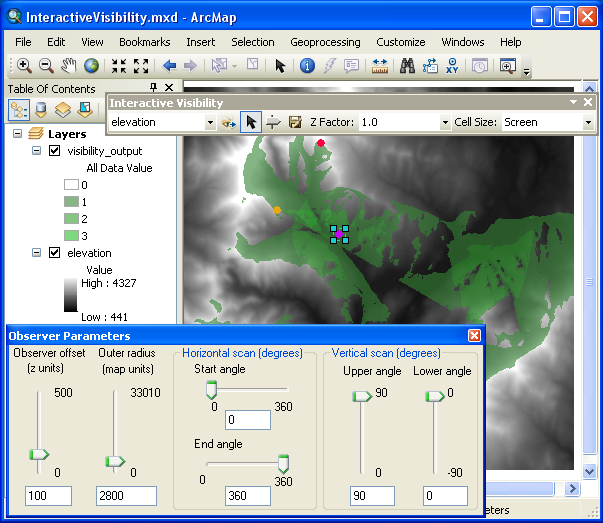With Spatial Analyst you can perform visibility analysis, but you may have found that altering the parameters of the operation can be a little tedious. Well, we have a new solution for you! Available for download is a new Interactive Visibility add-in toolbar.
Background
A viewshed identifies the cells in an input raster that can be seen from one or more observation locations. Traditionally, the Viewshed and Observer Points geoprocessing tools have been used for visibility analysis in ArcGIS for Desktop. These tools take two inputs, a raster elevation surface and a feature input identifying the observer locations. This means two things. First, you had to have a feature dataset of points already prepared. Second, while you could control the vertical and horizontal fields of view each observer, as well as the visibility distance limit, this had to be done through the attributes of the featureclass. Certainly capable, but not particularly easy to adjust and model different scenarios with.
Interactive Visibility toolbar Add-in
This toolbar provides a dynamic, interactive way to create viewsheds on a raster surface.
With this add-in you can:
- Add observation locations directly on the map with a cursor.
- See the combined viewsheds of all your observation locations update as you add more of them to your map display.
- Adjust the location of any existing observer point, and see the viewshed update based on the the new observer location.
- Change the field of view for each location dynamically.
While the default behaviour of the Add-in achieves good performance by using the screen resolution to determine visibility, you can also specify that calculations be performed at the full resolution of the data, trading off some performance for greater accuracy.
Downloading and installing
The Interactive Visibility toolbar Add-in is available for download here:
http://esriurl.com/InteractiveVisibility
The Add-In is supported for ArcGIS version 10.1 and beyond.
Learn more about Add-ins for ArcGIS Desktop 10.


Commenting is not enabled for this article.